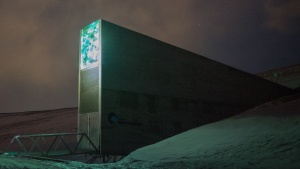
By Frode Ramone from Oslo, Norway – DSCF0896.jpg,
CC BY 2.0, https://commons.wikimedia.org/w/index.php?curid=61440340
Bad-ass Viking Scientists. That’s how I think about the Svalbard Global Seed Vault and the Arctic World Archive. Norway is a culture who looks at the world dying and rebuilding as a given – and have prepped to jump start the next cycle after Ragnarok. The whole world is betting on them pulling it off.
Around the world, over 1,700 seed banks exist as a stop-gap between starvation and human stupidity – with Svalbard being the final line in the snow. At this time, 95% of humanity’s food comes from 30 crops. Monoculture agriculture at its scary finest. In case something happens like (cough) climate change (cough) making some of the food crops non-viable, humans (in an amazing feat of intelligence) have set aside historic seed for biodiversity.
Doing so wasn’t easy. Bad-ass Scientists around the world have died saving this hedge in the seed banks against humanity’s bone-headiness. The St. Petersburg gene bank faced sure destruction during the siege of Leningrad from hungry citizens and a starving German army. The Russian scientists locked themselves in their vault, and some died waiting for the conflict to end surrounded by grain seed they could have eaten, hungry but never hungry enough to compromise their principles.
And just in case you were thinking this is all a pie-in-the-sky-someday-thing, in 2015 the first withdrawal of seed occurred. The Syria Seed Bank had been heavily damaged in a civil war and forced to be abandoned, so they asked for their wheat and barley seeds back. They had sent extra off to the Bad-ass Vikings for storage in the Doomsday Vault, as it is nicknamed. Doomsday just came a little early for them. The Bad-ass Farming Scientists then planted that defrosted seed in Lebanon’s Bekaa Valley and in Morocco – since home still wasn’t safe, and collected the seed, splitting it between their hopefully future rebuilt seed bank and the Doomsday.
Not having enough to do, the Viking Scientists decided to add a Data vault as well. They came up with data storage materials that can last 500 to 1000 years and offered their services to the world. They aren’t asking for the originals, just copies of what countries want to save. Like the golden record of Voyager.
“The data will remain searchable online … as long as the internet and servers are still functioning.” (Jones 2017)
A chilling thought, not to have the internet. But that is what Doomsday Vault is about. Against just that eventuality. Brazil and Mexico sent the first materials, Brazil from a collection of more than 300 life stories recorded between 2006 and 2016, and Mexico copies of documents dating back to the Inca period.
addition 2019 – Since the initial deposit in 2015, other government and governmental agencies has sent in material. Such as manuscripts form the Vatican Library and the European Space Agency recording of data acquired by a 1991 satellite. (Piql 2019)
Scientists united around the world, picking up keyboards, digging holes, saving genetic material, and grinning with bloody teeth against humanity’s self-destructive tendencies and a planet who both is our mother and ready to throw the baby out with the bathwater. Geeking Science – Hear the Nerds ROAR!
Bibliography
Duggan, Jennifer. “Inside the ‘Doomsday’ Value.” Time. (undated). https://time.com/doomsday-vault/ – Last viewed 12/2/2019.
Jones, Rhett. “Norway Gets a New Doomsday Vault That Stores Data.” Gizmodo. 2017 April 2 at 11:37 AM. https://gizmodo.com/norway-gets-a-second-doomsday-vault-that-stores-data-1793935778 – Last viewed 12/2/2019.
McCoy, Daniel. “Ragnarok.” Norse Mythology for Smart People. 2012-2019. https://norse-mythology.org/tales/ragnarok/ – Last viewed 12/2/2019.
Wikipedia. “Svalbard Global Seed Value.” (undated). https://en.wikipedia.org/wiki/Svalbard_Global_Seed_Vault – Last viewed 12/2/2019.
Addition 2019
Piql.com. “Arctic World Archive receives more world treasures.” 2019 February 21. – Last viewed 12/2/2019. (note – Piql oversees the Arctic World Archive)